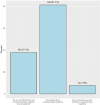Bridging the knowledge-practice gap: A cross-sectional survey assessing physician knowledge, attitude and practice toward complementary and alternative medicine
- PMID: 40367283
- PMCID: PMC12077789
- DOI: 10.1371/journal.pone.0322613
Bridging the knowledge-practice gap: A cross-sectional survey assessing physician knowledge, attitude and practice toward complementary and alternative medicine
Abstract
Complementary and alternative medicine (CAM) is widely used in multiple countries, including Saudi Arabia, yet its integration into mainstream healthcare requires evidence-based guidance. However, little is known about the current level of awareness attitudes and practice of physicians regarding CAM in Jazan region, which is a predominantly rural region in the southwestern part of Saudi Arabia. This region is known for its diverse residents with unique cultural and healing practices. The study aimed to assess physicians' awareness, attitudes, and practices regarding CAM in the Jazan region. We conducted a cross-sectional survey among physicians in five governorates of Jazan using convenience sampling. The structured questionnaire explored CAM-related awareness, attitudes, and practices. Data were analyzed using descriptive and inferential statistics to identify associated factors. Of 159 responding physicians (58.5% male and 41.5% females), 81.1% were aware of CAM, but only 7.5% had received formal pre-service training. Attitudes towards CAM were generally positive, with a median attitude score of 23 (out of a total of 30), particularly towards the need for more research and education on CAM. However, despite the generally positive attitudes toward CAM, only 25.8% of physicians reported plans to integrate CAM into their practice, and 37.7% had previously recommended CAM therapies to their patients. Factors significantly associated with awareness and practice included age, gender, work experience, and healthcare setting. In conclusion, despite high awareness and positive attitudes towards CAM among Jazan physicians, there is a significant gap in formal training and limited integration into practice, a matter which underscores the need for further exploration of the factors influencing this discrepancy.
Copyright: © 2025 Salih et al. This is an open access article distributed under the terms of the Creative Commons Attribution License, which permits unrestricted use, distribution, and reproduction in any medium, provided the original author and source are credited.
Conflict of interest statement
I have read the journal's policy and the authors of this manuscript declare that they have no competing interests.
Figures



Similar articles
-
Knowledge and attitudes of primary health care physicians towards complementary and alternative medicine in the Riyadh region, Saudi Arabia.Forsch Komplementmed. 2012;19(1):7-12. doi: 10.1159/000335814. Epub 2012 Feb 2. Forsch Komplementmed. 2012. PMID: 22398920
-
Knowledge, perception, attitude, and practice of complementary and alternative medicine by health care workers in Garki hospital Abuja, Nigeria.BMC Complement Med Ther. 2024 May 9;24(1):177. doi: 10.1186/s12906-024-04429-x. BMC Complement Med Ther. 2024. PMID: 38724936 Free PMC article.
-
Physicians' and nurses' perceptions and attitudes toward sickle cell disease patients in Jazan, Saudi Arabia.Saudi Med J. 2020 Aug;41(8):841-848. doi: 10.15537/smj.2020.8.25183. Saudi Med J. 2020. PMID: 32789425 Free PMC article.
-
Healthcare professionals' perception and practice of complementary and alternative medicine in Qassim region, Saudi Arabia.J Infect Dev Ctries. 2023 Dec 31;17(12):1782-1790. doi: 10.3855/jidc.18068. J Infect Dev Ctries. 2023. PMID: 38252731
-
Knowledge, attitude, and practices of complementary and alternative medicine: a survey of physicians and nurses at an academic medical center in Beirut.Libyan J Med. 2022 Dec;17(1):2071813. doi: 10.1080/19932820.2022.2071813. Libyan J Med. 2022. PMID: 35603591 Free PMC article.
References
MeSH terms
LinkOut - more resources
Full Text Sources
Medical
Miscellaneous

